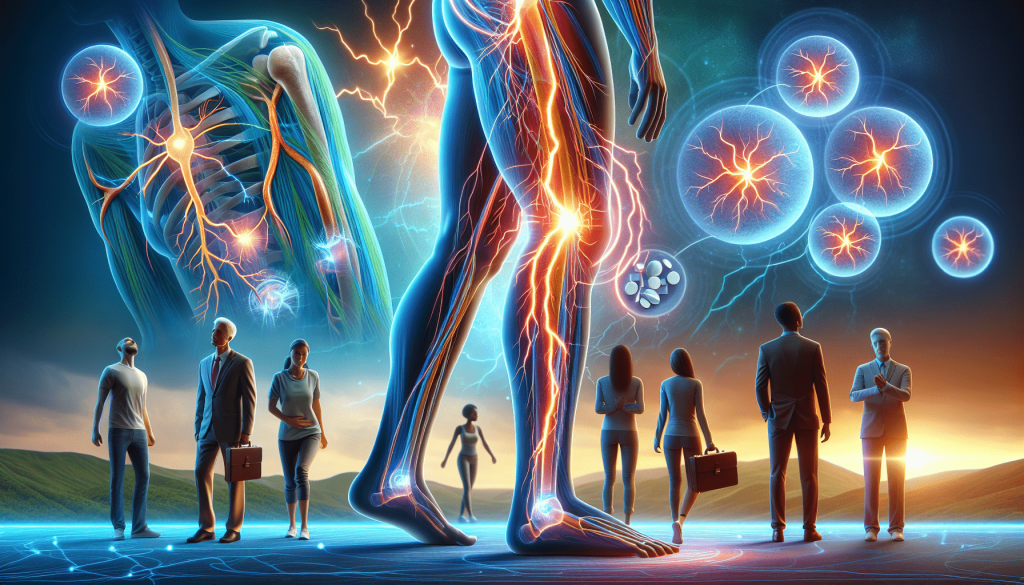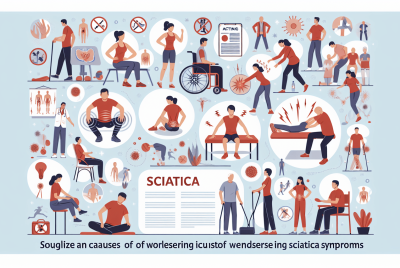What Painkillers Are Good For Sciatica?
What Painkillers Are Good For Sciatica?
When it comes to finding relief from the debilitating pain of sciatica, you may be wondering which painkillers are the most effective. Whether you’re experiencing a shooting pain down your leg or a persistent ache in your lower back, there are several over-the-counter and prescription options to consider. From non-steroidal anti-inflammatory drugs (NSAIDs) to muscle relaxants, this article explores the various painkillers that can provide the best relief for sciatica, helping you regain control of your life and put an end to the discomfort.
What Painkillers Are Good For Sciatica? Here are the list for Over-the-counter painkillers
When it comes to managing sciatica pain, over-the-counter painkillers can be a great option. They are easily accessible, affordable, and can provide effective relief. Three common over-the-counter painkillers that are often recommended for sciatica pain are Ibuprofen, Naproxen, and Acetaminophen.
Ibuprofen
Ibuprofen is a nonsteroidal anti-inflammatory drug (NSAID) that can help reduce inflammation and alleviate sciatica pain. It works by blocking the production of certain chemicals in the body that cause pain and inflammation. Ibuprofen is available in various strengths, and it is important to follow the recommended dosage instructions provided on the packaging. It is generally safe to take Ibuprofen for short-term pain relief, but it is always advisable to consult with a healthcare professional before long-term use.
Naproxen
Similar to Ibuprofen, Naproxen is also an NSAID that can provide relief from sciatica pain by reducing inflammation. It is available in both prescription and over-the-counter strengths. Naproxen is known to have a longer duration of action compared to Ibuprofen, which means it can provide pain relief for a longer period of time. However, it is important to follow the recommended dosage and usage instructions to avoid any potential side effects. Like any medication, it is advisable to consult with a healthcare professional before using Naproxen for an extended period.
Acetaminophen
Acetaminophen, commonly known as Tylenol, is a pain reliever that does not have anti-inflammatory properties like Ibuprofen and Naproxen. However, it can still be effective in providing relief from sciatica pain by blocking pain signals in the brain. Acetaminophen is generally considered safe for short-term use, but it is important to follow the recommended dosage instructions to avoid any potential liver damage. It is always recommended to consult with a healthcare professional before starting any new pain management regimen.
Prescription painkillers
In some cases, over-the-counter painkillers may not provide sufficient relief for severe or chronic sciatica pain. In such instances, prescription painkillers prescribed by a healthcare professional may be necessary. There are several types of prescription painkillers that can be used for sciatica pain, including narcotics, muscle relaxants, and even certain antidepressants.
Narcotics
Narcotics, also known as opioids, are strong painkillers that are often prescribed for severe sciatica pain that does not respond to other treatments. Examples of narcotics commonly prescribed for sciatica pain include Morphine, Codeine, and Oxycodone. These medications work by binding to opioid receptors in the brain and spinal cord, effectively blocking pain signals. Narcotics can be highly effective in providing immediate relief, but they come with a risk of dependence and addiction. Therefore, it is important to use them under the guidance of a healthcare professional and only as prescribed.
Muscle relaxants
Muscle relaxants are another type of prescription medication that can be used to manage sciatica pain. These medications work by relaxing the muscles and reducing muscle spasms, which can contribute to sciatica pain. Commonly prescribed muscle relaxants for sciatica pain include Cyclobenzaprine, Methocarbamol, and Baclofen. It is important to note that muscle relaxants can cause drowsiness and should be used with caution, especially when driving or operating machinery. They should only be used as prescribed and under the guidance of a healthcare professional.
Antidepressants
In some cases, certain antidepressant medications can also be prescribed to manage sciatica pain. Tricyclic antidepressants (TCAs) such as Amitriptyline and Selective Serotonin Reuptake Inhibitors (SSRIs) like Duloxetine are known to have pain-relieving properties. These medications work by affecting the levels of certain neurotransmitters in the brain that are involved in the perception of pain. While these medications are primarily used to treat depression, they can be effective in managing sciatica pain as well. It is important to discuss with a healthcare professional to determine the most suitable antidepressant for individual circumstances.
Nonsteroidal anti-inflammatory drugs (NSAIDs)
Nonsteroidal anti-inflammatory drugs (NSAIDs) are a class of medications that can help reduce inflammation and provide pain relief. Two commonly used NSAIDs for sciatica pain are Ibuprofen and Naproxen, which have been discussed earlier. These medications can be effective in reducing inflammation around the compressed nerve and alleviating pain. However, it is important to note that long-term use of NSAIDs can have side effects such as stomach ulcers or kidney problems. Therefore, it is always advisable to use NSAIDs as directed and under the guidance of a healthcare professional.

Acetaminophen
Acetaminophen is a pain reliever that is commonly used for various types of pain, including sciatica pain. It works by blocking pain signals in the brain and does not have anti-inflammatory properties like NSAIDs. Acetaminophen is generally considered safe when used according to the recommended dosage instructions. However, it is important to note that excessive or prolonged use of Acetaminophen can cause liver damage. Therefore, it is crucial to follow the recommended dosage and to consult with a healthcare professional before long-term use.
Usage
Acetaminophen is typically taken orally in tablet or liquid form. It is important to read the packaging instructions carefully and follow the recommended usage guidelines. Acetaminophen can be taken with or without food, but some individuals may find it easier on their stomach to take it with food or milk. It is essential to avoid exceeding the maximum daily dose recommended by the packaging or healthcare professional.
Dosage
The appropriate dosage of Acetaminophen for sciatica pain can vary depending on various factors such as the individual’s age, weight, and overall health. It is best to consult with a healthcare professional to determine the correct dosage for your specific situation. As a general guideline, the typical recommended adult dose of Acetaminophen is 325-1000mg every 4-6 hours, with a maximum daily dose of 4,000mg. However, it is crucial to follow the specific instructions provided by the packaging or healthcare professional.
Side effects
When taken as directed and within the recommended dosage, Acetaminophen is generally considered safe and well-tolerated. However, like any medication, it can have potential side effects. Common side effects of Acetaminophen include upset stomach, nausea, and allergic reactions. In rare cases, large doses or prolonged use can cause liver damage, so it is important to avoid exceeding the maximum daily dose or using it for an extended period without medical supervision. If any unusual or severe side effects occur, it is important to seek medical attention immediately.
Narcotics
Narcotics, or opioids, are a category of prescription painkillers that can be used to manage severe or chronic sciatica pain. There are several different types of narcotics, each with varying strengths and effects. The three most commonly prescribed narcotics for sciatica pain relief are Morphine, Codeine, and Oxycodone.
Morphine
Morphine is a potent narcotic that is typically reserved for severe or intractable sciatica pain that does not respond to other treatments. It is usually administered in a hospital setting or under close medical supervision due to its strong effects and potential for addiction. Morphine works by binding to opioid receptors in the brain and spinal cord, effectively blocking pain signals. It is available in various formulations, including oral tablets, liquid, and injectable forms. As with any narcotic, it is important to use Morphine strictly as prescribed and under the guidance of a healthcare professional.
Codeine
Codeine is a less potent narcotic compared to Morphine but can still provide effective pain relief for certain individuals with sciatica pain. It is often combined with other medications, such as Acetaminophen and Ibuprofen, to enhance its pain-relieving effects. Codeine is usually available in tablet or liquid form and is taken orally. Like other narcotics, Codeine has the potential for addiction and should only be used as directed by a healthcare professional.
Oxycodone
Oxycodone is another potent narcotic that is commonly prescribed for severe sciatica pain. It is available in immediate-release and extended-release formulations, allowing for both short-term and long-term pain relief. Oxycodone works by binding to opioid receptors in the brain and blocking pain signals. It is crucial to follow the prescribed dosage and usage instructions when using Oxycodone, as it can also lead to dependence and addiction. It is generally recommended to use Oxycodone for short-term pain relief under the supervision of a healthcare professional.
Muscle relaxants
Muscle relaxants are medications commonly prescribed for sciatica pain caused by muscle spasms or tension. They work by reducing muscle contractions and promoting relaxation, thus relieving the associated pain. Three commonly used muscle relaxants for sciatica pain relief are Cyclobenzaprine, Methocarbamol, and Baclofen.
Cyclobenzaprine
Cyclobenzaprine is a muscle relaxant that is frequently prescribed for muscle spasms and associated pain caused by sciatica. It works by blocking nerve impulses in the brain and spinal cord, thus reducing muscle contractions and relieving pain. Cyclobenzaprine is typically taken orally in tablet form. It is important to follow the recommended dosage instructions and to inform the healthcare professional about any existing medical conditions or medications, as they may interact with Cyclobenzaprine.
Methocarbamol
Methocarbamol is another muscle relaxant that is commonly used for the management of sciatica pain. It acts by depressing the central nervous system and relieving muscle spasms. Methocarbamol is usually taken orally in tablet form. It is important to follow the prescribed dosage and to inform the healthcare professional about any potential interactions with other medications or medical conditions.
Baclofen
Baclofen is a muscle relaxant that can be prescribed for sciatica pain associated with muscle spasms. It works by inhibiting the release of certain neurotransmitters, thus reducing muscle activity and relieving pain. Baclofen is usually available in tablet or liquid form. Like other muscle relaxants, it is important to follow the prescribed dosage and usage instructions and to inform the healthcare professional about any potential interactions or medical conditions.
Antidepressants
While primarily used to treat depression, certain antidepressants can also be effective in managing sciatica pain. They work by modulating the levels of certain neurotransmitters in the brain that are involved in pain perception. Three classes of antidepressants that may be prescribed for sciatica pain relief are Tricyclic Antidepressants (TCAs), Selective Serotonin Reuptake Inhibitors (SSRIs), and Serotonin-Norepinephrine Reuptake Inhibitors (SNRIs).
Tricyclic antidepressants
Tricyclic Antidepressants (TCAs) such as Amitriptyline and Nortriptyline have been used for many years to manage chronic pain, including sciatica pain. They work by inhibiting the reuptake of norepinephrine and serotonin, thus increasing their levels in the brain. This modulation of neurotransmitters can help reduce pain signals and alleviate sciatica pain. It is important to note that TCAs may have side effects such as drowsiness and dry mouth, and they should be used under the professional guidance of a healthcare provider.
Selective serotonin reuptake inhibitors (SSRIs)
Selective Serotonin Reuptake Inhibitors (SSRIs) such as Duloxetine are a newer class of antidepressants that can also be used for sciatica pain relief. They primarily work by increasing the levels of serotonin in the brain, which can help modulate pain signals and provide pain relief. SSRIs are generally well-tolerated and may have fewer side effects compared to TCAs. However, it is crucial to consult with a healthcare professional to determine the most appropriate SSRI and dosage for individual circumstances.
Serotonin-norepinephrine reuptake inhibitors (SNRIs)
Serotonin-Norepinephrine Reuptake Inhibitors (SNRIs) such as Venlafaxine are another class of antidepressants that can be used to manage chronic pain, including sciatica pain. They work by increasing the levels of both serotonin and norepinephrine in the brain, which can help modulate pain signals. SNRIs are similar to SSRIs in terms of their pain-relieving effects but may have different side effect profiles. It is important to consult with a healthcare professional to determine the most suitable SNRI and dosage for individual circumstances.
Steroids
Steroids, also known as corticosteroids, are a class of medication that can help reduce inflammation and relieve pain. They are typically prescribed when other pain management options have not provided sufficient relief. There are two main types of steroids used for sciatica pain: oral steroids and epidural steroid injections.
Oral steroids
Oral steroids, such as Prednisone or Medrol, are taken by mouth in the form of tablets or liquid. They work by reducing inflammation and suppressing the immune system’s response, thus alleviating pain. Oral steroids are generally prescribed for a short period of time, as they can have potential side effects when used long-term. Common side effects of oral steroids include increased appetite, weight gain, and mood changes. It is important to follow the prescribed dosage and duration as directed by a healthcare professional.
Epidural steroid injections
Epidural steroid injections involve the delivery of corticosteroids directly into the epidural space around the spinal nerves. This targeted approach allows for more concentrated pain relief in the affected area. Epidural steroid injections are typically performed by a healthcare professional, such as an anesthesiologist or pain management specialist, using fluoroscopy or ultrasound guidance. The injection can provide significant pain relief, although the effects are usually temporary. It is important to discuss the potential risks and benefits of epidural steroid injections with a healthcare professional before deciding on this treatment option.
Topical creams and patches
Topical creams and patches can be used as an adjunct to oral medication to provide localized pain relief for sciatica pain. They can be particularly beneficial for individuals experiencing discomfort in specific areas. Two commonly used topical treatments for sciatica pain are Capsaicin cream and Lidocaine patches.
Capsaicin cream
Capsaicin cream is derived from chili peppers and can be applied topically to alleviate sciatica pain. It works by numbing the skin and desensitizing the area, thus reducing pain sensations. Capsaicin cream should be applied sparingly to the affected area, following the instructions provided on the packaging. It is important to note that capsaicin cream may cause a mild burning or tingling sensation initially, but this usually subsides with regular use.
Lidocaine patches
Lidocaine patches are another topical treatment option for sciatica pain that can be easily applied to the affected area. Lidocaine is a local anesthetic that works by blocking nerve signals associated with pain. The patches provide a localized numbing effect, providing relief from discomfort. Lidocaine patches should be applied as directed and should not be left on for longer than the recommended duration. It is important to follow the packaging instructions and consult with a healthcare professional if any adverse reactions occur.
Non-pharmacological treatments
In addition to medication, non-pharmacological treatments can also play a significant role in managing sciatica pain. These alternative therapies can be used independently or in conjunction with medication to provide holistic relief. Some common non-pharmacological treatments for sciatica pain include physical therapy, chiropractic care, and acupuncture.
Physical therapy
Physical therapy focuses on improving flexibility, strength, and mobility to reduce sciatica pain and prevent future flare-ups. A physical therapist can design a customized exercise program that targets specific muscle imbalances and helps alleviate pressure on the affected nerve. Physical therapy may also include other modalities such as heat or cold therapy, ultrasound, or electrical stimulation to further reduce pain and promote healing.
Chiropractic care
Chiropractic care involves manual manipulation of the spine to correct any misalignments or imbalances that may be contributing to sciatica pain. Chiropractors use specific techniques to alleviate pressure on the affected nerve and restore proper spinal alignment. This can help reduce inflammation and promote nerve healing. Chiropractic care may also involve other complementary treatments such as massage therapy, stretching, and strengthening exercises.
Acupuncture
Acupuncture is an ancient Chinese practice that involves the insertion of thin needles into specific points on the body to promote healing and alleviate pain. It is believed to help rebalance the flow of energy, or Qi, within the body, thus relieving pain and promoting overall well-being. Acupuncture has been found to be effective in reducing sciatica pain and improving quality of life. It is important to seek a licensed acupuncturist who has experience in treating sciatica pain.
In conclusion, there are various painkillers and treatments available for managing sciatica pain. Over-the-counter painkillers such as Ibuprofen, Naproxen, and Acetaminophen can provide temporary relief, while prescription painkillers such as narcotics, muscle relaxants, and certain antidepressants may be necessary for more severe pain. Nonsteroidal anti-inflammatory drugs (NSAIDs) like Ibuprofen and Naproxen can help reduce inflammation, and Acetaminophen can provide pain relief without anti-inflammatory properties. It is crucial to follow the recommended dosage and usage instructions for all medications and to consult with a healthcare professional for personalized advice. Steroids, topical creams, and patches can also be used to reduce pain and inflammation. Additionally, non-pharmacological treatments like physical therapy, chiropractic care, and acupuncture can provide holistic relief and improve overall well-being for individuals suffering from sciatica pain. Remember, everyone’s experience with pain and treatment response may vary, so it is important to work closely with healthcare professionals to find the most effective and personalized pain management plan.




